Salmon run: An upstream battle that ends in life, and death
Wildlife weekend

The salmon run is one of the most remarkable journeys in the natural world: a journey that epitomises perseverance, demands supreme fitness and some exceptional navigational ability. A voyage that is all about life, yet ends in the death of its protagonists.
Atlantic salmon season in the UK usually lasts three or four weeks, from mid-October to mid-November, contingent upon autumn's first heavy rains. Head to Stainforth Force on the River Ribble in the Yorkshire Dales National Park, for an early morning or late afternoon start that will coincide with peak activity. Walk 100 metres south-east from the road bridge along the wooded river then seat yourself beside an obvious, of small, cascade.
It may be barely half a minute, or it may be half an hour. But if conditions are right, the fish will come. With a flash of silver, salmon leap four times their length to ascend the falls. Usually only larger fish make it first time, others crashing and burning. After recovering and refuelling, they venture once more into the fray.
Look closely to differentiate the darker females with a rainbow glimmer on their sides from the red-bellied, streaky-flanked males. That both sexes head in the same direction makes their purpose clear: to spawn. And herein lies what is extraordinary about the salmon story. The salmon that you see hatched in this very river up to four years ago. They left as youngsters ("smolt"), fattening up in deep waters offshore.
Then, when the urge to breed proves irrepressible, they navigate back to their birthplace by dint of stars, magnetic field, oceanic currents and "chemical memory". From the moment adults enter the freshwater system, they cease to eat. Surviving on reserves, their days are numbered.
October is also the month for red deer. While Halloween week is late on in the rut, a chance to view Britain's largest land mammal is hard to pass up. They are best seen at nearby RSPB Leighton Moss in Lancashire. Males should still be roaring, and you may spot the odd harem-flanked stag from Griesdale or Tim Jackson hides.
Closer to the ground, scan the tree trunks for fungi; late October is prime time. Look for blackfoot polypore, tawny funnel cap and lemon disco. Best of all, though, watch quietly for otter from Lower or Public hides – even if you are ending a fish-watching weekend by watching a fish-eater.
This is an edited extract from 52 Wildlife Weekends by James Lowen, published by Bradt. IoS readers can buy a copy for £7.79 by visiting bradtguides.com and using the discount code 52WW until 31 January 2015.
Subscribe to Independent Premium to bookmark this article
Want to bookmark your favourite articles and stories to read or reference later? Start your Independent Premium subscription today.

Join our commenting forum
Join thought-provoking conversations, follow other Independent readers and see their replies